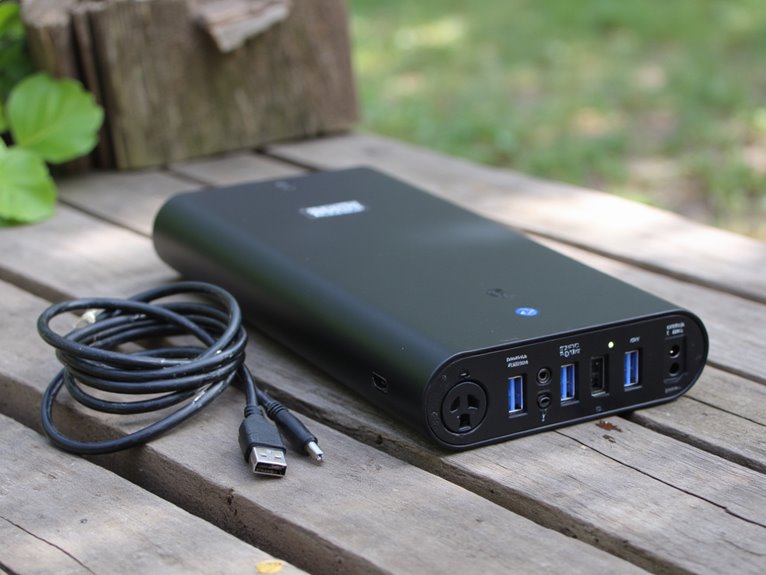Portable Power Station Buying Guide: Features, Ports, and Safety Certifications
When choosing a portable power station, you’ll need to evaluate battery capacity (256Wh to 2240Wh), inverter type (pure sine wave for electronics), and port variety (7-20 outlets including USB-C, AC, and DC). Look for essential safety certifications like UL 2743 and UN38.3, plus features like automatic shutoff and fire-resistant materials. Consider weight trade-offs—compact units under 20 pounds versus high-capacity models exceeding 60 pounds. Understanding these specifications guarantees you’ll select the best power solution for your specific applications.
We are supported by our audience. When you purchase through links on our site, we may earn an affiliate commission, at no extra cost for you. Learn more. Last update on 18th December 2025 / Images from Amazon Product Advertising API.
Notable Insights
- Choose battery capacity (measured in Wh) based on your power needs, with LiFePO4 offering 2000-5000+ charge cycles for better longevity.
- Select pure sine wave inverters for sensitive electronics, ensuring total device wattage doesn’t exceed the continuous power rating.
- Look for 7-20 ports including AC outlets, USB-A/C with Power Delivery, DC car ports, and wireless charging for device compatibility.
- Verify essential safety certifications like UL 2743, UL 9540A, FCC, and UN38.3 with automatic shutoff and fire-resistant materials.
- Consider weight-to-capacity trade-offs and mobility features like ergonomic handles, wheels, and weather-resistant IP65 rated construction.
Battery Capacity and Type Considerations
When choosing a portable power station, battery capacity serves as the most critical specification that determines how long you’ll be able to power your devices. Measured in watt-hours (Wh), capacity directly affects runtime—a 2240Wh unit powers a 1000W microwave for two hours, while 3000Wh extends that to 2.7 hours.
Battery capacity in watt-hours determines your device runtime—higher Wh means longer power, but consider the trade-off with increased weight.
You’ll encounter two main battery types: standard lithium-ion and Lithium Iron Phosphate (LiFePO4). LiFePO4 offers superior battery longevity with 2000-5000+ charge cycles versus typical li-ion’s shorter lifespan. LiFePO4 batteries provide a longer cycle life compared to conventional NCM Li-ion batteries, making them preferable for users seeking maximum durability.
These batteries use eco-friendly materials with better recyclability and reduced toxicity. LiFePO4 batteries also deliver consistent performance with steady voltage throughout the discharge cycle, ensuring your devices receive reliable power until the battery is nearly depleted. Though LiFePO4 costs more upfront, you’ll save long-term through fewer replacements.
Consider that higher capacity means increased weight—2000Wh units weigh 29-42kg, affecting portability for your intended use.
Inverter Output and Power Requirements
Battery capacity determines how much energy you’ll have available, but the inverter controls how you can actually use that stored power.
Understanding inverter types is essential for compatibility with your devices. Pure sine wave inverters produce clean AC power suitable for sensitive electronics, while modified sine wave versions are cheaper but may cause interference.
Pay attention to continuous versus peak power ratings. Peak power indicates maximum short-term output (typically 2-3 times continuous rating) for handling startup surges from appliances like refrigerators.
Your total device wattage shouldn’t exceed the continuous rating to prevent shutdowns.
Most units output standard regional voltages (120V/60Hz in the US, 240V/50Hz in Europe). Higher-efficiency inverters approaching 90-95% maximize your available runtime.
Available Ports and Connectivity Options
Modern portable power stations typically feature 7-20 different ports, transforming a single battery unit into an extensive charging hub for multiple devices. This port diversity guarantees charging compatibility across smartphones, laptops, appliances, and specialized equipment.
You’ll find AC outlets ranging from 100W to over 2000W capacity, USB-A ports delivering 5V at 2.4A with Quick Charge 3.0, and USB-C ports supporting Power Delivery up to 18W or higher.
DC car ports provide 12V output for automotive accessories, while wireless charging pads offer cable-free convenience at 5-10W. Effective power management systems optimize output efficiency across simultaneous connections.
This connectivity flexibility enhances user experience through intelligent port accessibility and tech integration, supporting everything from medical equipment to camping gear with seamless device support.
Essential Safety Certifications and Features
Since portable power stations contain high-capacity lithium batteries and deliver substantial electrical output, they must undergo rigorous safety testing and certification before reaching consumers.
Rigorous safety testing and certification are mandatory for portable power stations due to their high-capacity batteries and substantial electrical output.
You’ll want to verify specific certifications when evaluating models for purchase.
Essential certification processes include these mandatory requirements:
- UL 2743 and UL 9540A certifications guarantee thermal runaway protection and fire resistance testing for U.S. market compliance.
- FCC certification assures electromagnetic compatibility and prevents radio frequency interference with other devices.
- UN38.3 certification validates lithium battery transportation safety through overcharge, short circuit, and impact testing protocols.
Critical safety measures you should expect include automatic shutoff mechanisms, electrical isolation systems, and built-in monitoring for temperature anomalies.
Fire-resistant materials and proper ventilation prevent thermal runaway events. These certifications aren’t optional—they’re your assurance that the unit meets international safety standards.
Portability and Design Factors
When you’re selecting a portable power station, the unit’s physical characteristics directly impact its real-world usability across different scenarios.
Weight becomes the primary limiting factor for transport, with units under 20 pounds offering the best balance between capacity and individual carrying comfort.
Beyond basic dimensions, you’ll need to evaluate specific mobility features, construction materials, and build quality standards that determine long-term durability and field performance.
Weight and Size Considerations
Although portable power stations share the same basic function, their weight and size vary dramatically—from compact 2.75-pound units that slip into backpacks to hefty 60-pound behemoths requiring wheels for transport.
Weight limitations directly impact your mobility options. Lightest models (2.75-7 lbs) excel for hiking and camping, while heavier units exceeding 20 pounds suit stationary applications.
Size upgrades correlate with increased battery capacity—compact units measure 7×4×2 inches with basic power output, whereas larger models reach 15×8×11 inches with multi-kWh capacities.
Consider these weight-to-capacity trade-offs:
- Ultra-light units (under 7 lbs): 288-500 Wh capacity, ideal for phones and tablets
- Mid-range models (10-20 lbs): 500-1000 Wh capacity, powers laptops and small appliances
- Heavy-duty stations (20+ lbs): 1000+ Wh capacity, runs larger devices and multiple outputs simultaneously
Mobility Features Available
Five critical mobility features separate truly portable power stations from cumbersome alternatives that defeat their intended purpose. Ergonomic handles reduce hand fatigue during transport, while integrated wheels enable effortless movement across varied terrain. Weight balance prevents tipping and guarantees stable handling.
| Feature | Benefit |
|---|---|
| Telescoping handles | Luggage-style mobility for heavy units |
| Retractable wheels | Storage without added bulk |
| Carrying straps | Hands-free transport options |
| Modular designs | Magnetic stacking for expanded capacity |
Stacking options allow multiple units to connect magnetically, expanding power capacity while maintaining compact footprints. Units under 20 pounds support individual carrying without assistance. Rugged wheels handle unpaved surfaces effectively. Low center-of-gravity layouts prevent accidental falls on uneven ground, making these features essential for outdoor adventures.
Build Quality Standards
Since portable power stations face demanding conditions from outdoor adventures to emergency backup scenarios, their construction must withstand significant abuse while maintaining electrical integrity.
Material durability determines whether your investment survives drops, impacts, and harsh weather exposure.
Quality units feature three critical construction elements:
- Rugged protective casing – High-impact plastics or reinforced composites resist cracking and deformation
- Weather sealing – IP65-rated protection prevents dust and moisture ingress into sensitive components
- Internal shock absorption – Padding protects battery cells and circuits from jarring during transport
Structural resilience comes from metal alloy frames that add strength without excessive weight.
Premium models incorporate fire-retardant materials and balanced weight distribution for stability. Reinforced stitching techniques borrowed from high-performance textile manufacturing enhance stress point durability where handles and straps attach to the main housing.
Ergonomic handles and accessible ports reduce accidental damage risks while maintaining robust protection for internal components.
Like dehumidifiers that must perform optimally within specific temperature ranges while protecting sensitive equipment, portable power stations require consistent environmental controls to maintain battery performance and prevent component degradation.
Charging Methods and Performance Applications
Your power station’s charging capabilities directly impact its usefulness across different scenarios, from emergency backup to outdoor adventures.
Modern units offer multiple charging methods including AC wall outlets, solar panels, 12V car adapters, and USB-C Power Delivery, each with distinct speed and application advantages.
Understanding these charging options and matching them to your specific performance needs guarantees you’ll select a station that recharges efficiently when and where you need it most.
Multiple Charging Options
Modern portable power stations support multiple charging methods, each offering distinct advantages for different scenarios and user needs.
Understanding your charging infrastructure requirements enables better efficiency analysis when selecting compatible devices.
You’ll encounter four primary charging methods:
- AC wall outlet charging – Delivers 60W to 1800W input power for fastest charging speeds, though requires grid access.
- DC car charging – Utilizes 12V vehicle outlets for mobile charging flexibility with slower performance than AC methods.
- USB-C Power Delivery – Provides portable charging through PD-compatible devices, typically offering lower wattage but enhanced convenience.
Solar panel charging offers off-grid capabilities but depends heavily on weather conditions.
Your choice depends on intended use scenarios, available power sources, and required charging speeds for peak performance.
Fast Recharge Technologies
While standard charging methods get the job done, fast recharge technologies transform portable power stations from convenient backup devices into reliable primary power sources by drastically reducing downtime.
You’ll find AC wall charging delivers the fastest results—the DJI Power 500 reaches full capacity in 70 minutes, while the EcoFlow River 3 completes charging in just one hour.
LiFePO4 battery chemistry enables this rapid fast charging without compromising battery longevity. These batteries support 3000+ charge cycles, translating to approximately 10 years of daily use.
Advanced models employ DC coupling to boost charging efficiency by 40%, while stable voltage control eliminates trickle charging phases.
Battery Management Systems protect against overcurrent and overheating during rapid charging sessions.
Application-Specific Performance Needs
Determining the right charging method depends entirely on how you’ll use your portable power station, as each application demands different recharge speeds and power capabilities.
For home backup scenarios, you’ll need rapid AC wall charging with 100W to 1800W input capacity. Higher capacity units above 500Wh require powerful chargers or multiple simultaneous inputs to achieve practical recharge times during emergencies.
Different applications require specific charging strategies:
- Emergency backup – AC wall charging provides fastest recovery between outages
- Off grid solutions – Solar panels deliver renewable energy independence for extended remote use
- Mobile applications – Car charging offers convenient on-the-go power replenishment
Heavy tool use demands quick turnaround times, making high-wattage AC charging essential.
Renewable energy applications prioritize solar compatibility over speed, while travel scenarios benefit from versatile USB-C PD options.
Frequently Asked Questions
How Long Do Portable Power Station Batteries Typically Last Before Needing Replacement?
Your portable power station’s battery lifespan typically ranges from 2-5 years with lithium-ion batteries, or up to 10 years with LiFePO4. Following proper maintenance tips like avoiding overcharging greatly extends longevity.
Can Portable Power Stations Be Used While Charging Simultaneously?
Yes, you can use portable power stations while charging through pass-through capability. However, simultaneous usage slightly reduces charging efficiency since power’s split between your devices and battery replenishment.
What’s the Difference Between Peak and Continuous Power Output Ratings?
Peak power ratings handle brief startup surges from appliances, while continuous ratings indicate steady long-term output. Understanding these power ratings guarantees you’ll select stations with proper energy efficiency for your specific needs.
On a final note
You’ve now got the technical knowledge to select a portable power station that matches your specific requirements. Focus on battery capacity that exceeds your calculated energy needs by 20-30%. Verify inverter output handles your highest-wattage devices. Prioritize units with UL, FCC, and UN38.3 certifications for safety compliance. Consider weight versus capacity trade-offs for your intended applications. Your investment depends on matching these technical specifications to your actual power demands and usage patterns.

